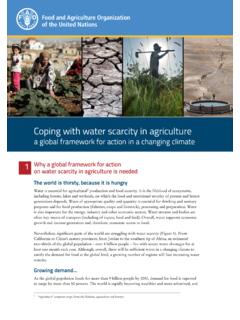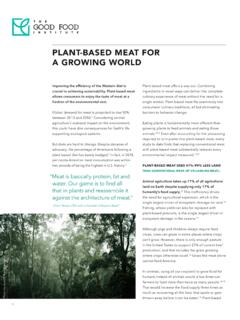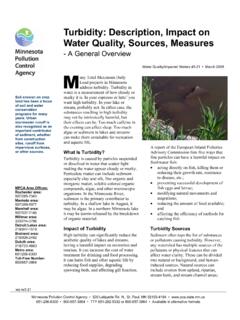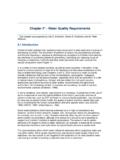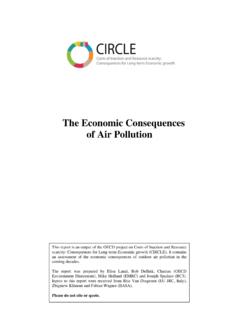Transcription of livestock’s long shadow - Food and Agriculture Organization
1 Livestock's long shadow environmental issues and options The Livestock, Environment and Development (LEAD) Initiative is supported by the World Bank, the European Union (EU), the Minist re des Affaires Etrang res (France), German Federal Ministry for Economic Cooperation and Development via GTZ (Germany), the Department for International Development (United Kingdom), the US Agency for International Development (USA), the International Development Agency (Denmark), the Swiss Agency for Development and Cooperation (Switzerland), the International Fund for Agricultural Development (IFAD) and the Food and Agriculture Organization of the United Nations (FAO). LEAD website: Photographs Page 2 and 3: USDA / Ken Hammond Page 22 and 23: USDA / Dana Downic Page 78 and 79: FAO / R. Faidutti Page 124 and 125: USDA NRCS / Gene Alexander Page 180 and 181: CIPAV Photograhic archive Page 220 and 221: FAO / H. Wagner Page 266 and 267: Nikolaus Schareika FOOD AND Agriculture Organization OF THE UNITED NATIONS.
2 Rome, 2006. livestock's long shadow Henning Steinfeld Pierre Gerber Tom Wassenaar Vincent Castel Mauricio Rosales Cees de Haan The designations employed and the presentation of material in this information product do not imply the expression of any opinion whatsoever on the part of the Food and Agriculture Organization of the United Nations concerning the legal or development status of any country, territory, city or area or of its authorities, or concerning the delimitation of its frontiers or boundaries. ISBN 978-92-5-105571-7. All rights reserved. Reproduction and dissemination of material in this information product for educational or other non-commercial purposes are authorized without any prior written permission from the copyright holders provided the source is fully acknowledged. Reproduction of material in this information product for resale or other commercial purposes is prohibited without written permission of the copyright holders. Applications for such permission should be addressed to the Chief, Publishing Management Service, Information Division, FAO, Viale delle Terme di Caracalla, 00100 Rome, Italy or by e-mail to FAO 2006.
3 Preface The in-depth assessment presented in this document of the various significant impacts of the world's livestock sector on the environment is deliberately termed Livestock's long shadow so as to help raise the attention of both the technical and the general public to the very substantial contribution of animal Agriculture to climate change and air pollution , to land, soil and water degradation and to the reduction of biodiversity. This is not done simply to blame the rapidly growing and intensifying global livestock sector for severely damag- ing the environment but to encourage decisive measures at the technical and political levels for mitigating such damage. The detailed assessment of the various environmental impacts of the sector is therefore associated with the outline of technical and policy- related action to address these impacts. The assessment builds on the work of the Livestock, Environment and Development (LEAD) Initiative. This multi-stakeholder Initiative, coordinated by FAO's Animal Production and Health Division, was formed to address the environmental consequences of livestock production, particularly in the light of rising demand for food products of animal origin and the increasing pressure on natural resources.
4 The LEAD Initiative brought together a broad range of research and development institutions and individuals interested in livestock environment interactions; it has been active in a number of areas of particular concern, in land and water pollution from intensive livestock production in land degra- dation from overgrazing in dry lands and in livestock-induced deforestation in the humid and subhumid tropics. While previous assessments of the livestock environment interactions by LEAD have adopted a livestock sector perspective, investigated the impacts of the sector on the natural resources used in animal production, the current assessment sets off from the environment and determines the contribution of livestock to changes to the environment (land use and climate change, soil, water and biodiversity depletion). The benefit of this change in perspective is substantial in that it provides the framework for gauging the sig- nificant and dynamic role of the livestock sector in driving global environmental change.
5 This in turn should assist and enhance decision-making on necessary action at all levels, from local to global, from private to public, from individual to corporate and from non- governmental to intergovernmental. Action is required: if, as predicted, the production of meat will double from now to 2050, we need to halve impacts per unit of output to achieve a mere status quo in overall impact. LEAD has been catalysing such action, supported by the Global Environment Facility (GEF) and other donors, in a range of livestock-induced environmental hotspots , such as in East and Southeast Asia where solutions are designed for the sustainable management of the very large quantities of livestock waste in intensive animal production, such as in Central America where new procedures are introduced for the payment of environmental services in livestock-based land use, and such as in the United Republic of Tanzania where iii sustainable wildlife livestock interactions are designed.
6 Such efforts require decisions on, and enforcement of, suitable policy instruments for enabling stakeholder engagement in economically sustainable resource use that addresses the environmental concerns at stake. It is obvious that the responsibility for the necessary action to address the environmental damage by the livestock sector goes far beyond the sector; it also goes beyond Agriculture . While the sector, and Agriculture as a whole, have to live up to the challenge of finding suitable technical solutions for more environmentally sustainable resource use in animal Agriculture , the decisions concerning their use clearly transcend Agriculture ; multisector and multiobjective decision-making is required. It is hoped that this assessment contributes to such decision-making and to thus shrink Livestock's long shadow . Samuel Jutzi Director Animal Production and Health Division FAO. iv Contents Acknowledgements xvi Abbreviations and acronyms xvii Executive summary xx Chapter 1.
7 Introduction 3. Livestock as a major player in global environmental issues 4. The setting: factors shaping the livestock sector 6. Trends within the livestock sector 14. Chapter 2. Livestock in geographic transition 23. Trends in livestock related land use 24. Overview: a regionally diverse pattern of change 24. Globalization drives national land-use change 27. Land degradation: a vast and costly loss 29. Livestock and land use: the geographical transition 31. Geography of demand 33. Geography of livestock resources 34. Pastures and fodder 34. Feedcrops and crop residues 38. Agro-industrial by-products 43. Future trends 45. Production systems: location economics at play 50. Historical trends and distribution patterns 51. Geographical concentration 57. Increasing reliance on transport 60. v Hotspots of land degradation 63. Pastures and feedcrops still expanding into natural ecosystems 64. Rangeland degradation: desertification and vegetation changes 66. Contamination in peri-urban environments 68.
8 Intensive feedcrop Agriculture 70. Conclusions 74. Chapter 3. Livestock's role in climate change and air pollution 79. Issues and trends 79. Livestock in the carbon cycle 84. Carbon emissions from feed production 86. Carbon emissions from livestock rearing 95. Carbon emissions from livestock processing and refrigerated transport 99. Livestock in the nitrogen cycle 101. Nitrogen emissions from feed-related fertilizer 104. Emissions from aquatic sources following chemical fertilizer use 105. Wasting of nitrogen in the livestock production chain 106. Nitrogen emissions from stored manure 107. Nitrogen emissions from applied or deposited manure 109. Emissions following manure nitrogen losses after application and direct deposition 111. Summary of livestock's impact 112. Mitigation options 114. Sequestering carbon and mitigating CO2 emissions 115. Reducing CH4 emissions from enteric fermentation through improved efficiency and diets 119. Mitigating CH4 emissions through improved manure management and biogas 121.
9 Technical options for mitigating N2O emissions and NH3 volatilization 122. vi Chapter 4. Livestock's role in water depletion and pollution 125. Issues and trends 125. water use 128. Drinking and servicing 128. Product processing 130. Feed production 133. water pollution 135. Livestock waste 136. Wastes from livestock processing 149. pollution from feed and fodder production 153. Livestock land-use impacts on the water cycle 162. Extensive grazing alters water flows 162. Land-use conversion 165. Summary of the impact of livestock on water 167. Mitigation options 169. Improved water -use efficiency 169. Better waste management 171. Land management 176. Chapter 5. Livestock's impact on biodiversity 181. Issues and trends 181. Dimensions of biodiversity 183. Livestock's role in biodiversity loss 187. Habitat change 187. Climate change 195. Invasive alien species 196. Overexploitation and competition 202. pollution 209. Summary of livestock impacts on biodiversity 214.
10 Mitigation options for conservation of biodiversity 215. vii Chapter 6. Policy challenges and options 221. Towards a conducive policy framework 222. General principles 222. Specific policy instruments 229. Policy issues in climate change 237. Policy issues in water 241. Policy issues in biodiversity 249. Policies options for addressing environmental pressure points 256. Controlling expansion into natural ecosystems 256. Limiting rangeland degradation 259. Reducing nutrient loading in livestock concentration areas 261. Lessening the environmental impact of intensive feedcrop production 263. Chapter 7. Summary and conclusions 267. Livestock and environment in context 268. What needs to be done? 275. The challenge ahead 281. References 285. Annexes 1. Global maps 321. 2. Tables 359. 3. Methodology of quantification and analysis 377. viii Tables Urbanization rates and growth rates 7. Changes in food consumption in developing countries 10. Use of feed concentrate 12.










